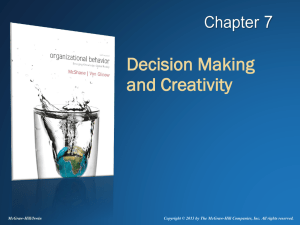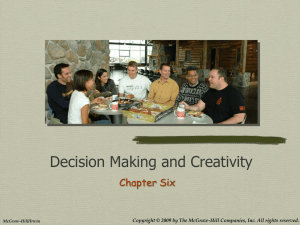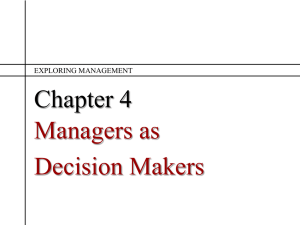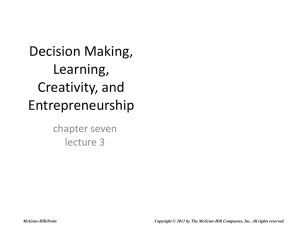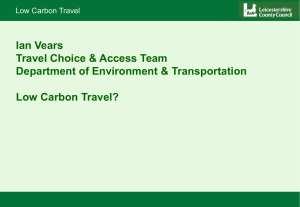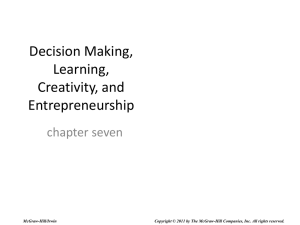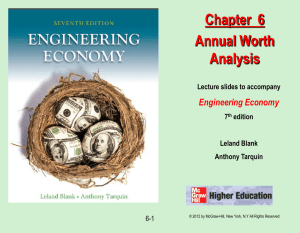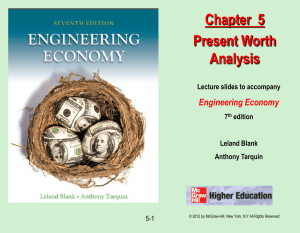Introduction to the Field of Organizational Behavior
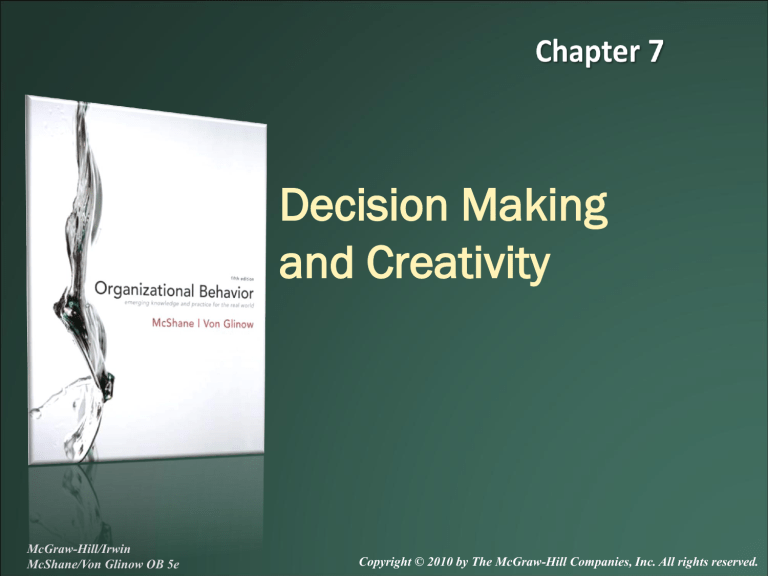
Decision Making and Creativity
McGraw-Hill/Irwin
McShane/Von Glinow OB 5e Copyright © 2010 by The McGraw-Hill Companies, Inc. All rights reserved.
Decision Making at Google
Google is a hotbed of creativity and innovation by giving staff 20 percent of their time to work on pet projects, using evidencebased experiments to test ideas, and involving employees in organizational decisions.
7-2
Decision Making Defined
Decision making is a conscious process of making choices among one or more alternatives with the intention of moving toward some desired state of affairs.
7-3
Rational Choice Decision Process
4
7-4
Rational Choice Decision Process
•
Identify problem/opportunity
Symptom vs problem
•
Choose decision process e.g. (non)programmed
•
Develop/identify alternatives
Search, then develop
•
Choose best alternative
Subjective expected utility
Implement choice
Evaluate choice
7-5
Problem Identification Process
Problems and opportunities are not announced or pre-defined
Use logical analysis and nonconscious emotional reaction during perceptual process
7-6
No Problem, Houston?
NASA’s space shuttle Columbia disintegrated during re-entry, killing all seven crewmembers. A special accident investigation board concluded that NASA’s middle management continually resisted attempts to recognize that the
Columbia was in trouble, and therefore made no attempt to prevent loss of life.
7-7
Problem Identification Challenges
Stakeholder framing
Perceptual defense
Mental models
Decisive leadership
Solution-focused problems
7-8
Identifying Problems Effectively
1.
Be aware of perceptual and diagnostic limitations
2.
Fight against pressure to look decisive
3.
Maintain “divine discontent”
(aversion to complacency)
4.
Discussing the situation with colleagues -- see different perspectives
7-9
Making Choices: Rational vs OB Views
Rational Choice
Paradigm Assumptions
Observations from
Organizational Behavior
Goals are clear, compatible, and agreed upon
Goals are ambiguous, conflicting, and lack agreement
People are able to calculate all alternatives and their outcomes
People evaluate all alternatives simultaneously
People have limited information processing abilities
People evaluate alternatives sequentially more
7-10
Making Choices: Rational vs OB Views
Rational Choice
Paradigm Assumptions
Observations from
Organizational Behavior
People use absolute standards to evaluate alternatives
People evaluate alternatives against an implicit favorite
People make choices using factual information
People choose the alternative with the highest payoff (SEU)
People make choices using perceptually distorted information
People evaluate alternatives sequentially
7-11
Biased Decision Heuristics
People have built-in decision heuristics that bias evaluation of alternatives
1.
Anchoring and adjustment – initial information (e.g., opening bid) influences evaluation of subsequent information
2.
Availability heuristic – we estimate probabilities by how easy we can recall the event, but other factors influence ease of recall
3.
Representativeness heuristic -- we estimate probabilities by how much they represent something
(e.g. stereotypes) in spite of better probability info
7-12
Paralyzed by Choice
Research has found that when decision makers are presented with more options, they are less likely to make any decision at all. This paralysis of choice occurs even when there are clear benefits of selecting any alternative (such as joining a company retirement plan).
7-13
Emotions and Making Choices
1.
Emotions form preferences before we consciously evaluate those choices
2.
Moods and emotions influence how well we follow the decision process
3.
We ‘listen in’ on our emotions and use that information to make choices
7-14
Intuitive Decision Making
Ability to know when a problem or opportunity exists and select the best course of action without conscious reasoning
•
•
Intuition as emotional experience
Gut feelings are emotional signals
Not all emotional signals are intuition
•
Intuition as rapid nonconscious analysis
Uses action scripts
7-15
Making Choices more Effectively
1.
Systematically evaluate alternatives against relevant factors
2.
Be aware of effects of emotions on decision preferences and evaluation process
3.
Scenario planning
7-16
Postdecisional Justification
Tendency to inflate quality of the selected option; forget or downplay rejected alternatives
Results from need to maintain a positive selfidentity
Initially produces excessively optimistic evaluation of decision
7-17
Escalation of Commitment
The tendency to repeat an apparently bad decision or allocate more resources to a failing course of action
•
•
•
•
Four main causes of escalation:
Self-justification
Prospect theory effect
Perceptual blinders
Closing costs
7-18
Evaluating Decisions More Effectively
1.
2.
3.
4.
Separate decision choosers from evaluators
Establish a preset level to abandon the project
Find sources of systematic and clear feedback
Involve several people in the evaluation process
7-19
Involvement at Thai Carbon Black
Thai Cabon Black, the Thai-
Indian joint venture, relies on employee involvement to boost productivity and quality.
Employees submit hundreds of suggestions in little red boxes located around the site
Participatory management meetings are held every month
7-20
Employee Involvement Defined
The degree to which employees influence how their work is organized and carried out
Different levels and forms of involvement
7-21
Employee Involvement Model
Employee
Involvement
Contingencies of Involvement
Potential Involvement
Outcomes
Better problem identification
Synergy produces more/better solutions
Better at picking the best choice
Higher decision commitment
7-22
Contingencies of Involvement
Higher employee involvement is better when:
Decision
Structure
• Problem is new & complex
(i.e nonprogrammed decision)
Knowledge
Source
• Employees have relevant knowledge beyond leader
Decision
Commitment
Risk of
Conflict
• Employees would lack commitment unless involved
1.
Norms support firm’s goals
2.
Employee agreement likely
7-23
Going for WOW at Nottingham-Spirk
Team members at Nottingham-Spirk Design Associates Inc. give coworker Craig Saunders (standing) a “WOW” rating for one of the firm's creative products, the SwifferVac.
NottinghamSpirk’s work environment supports creativity.
7-24
Creativity Defined
Developing an original idea that makes a socially recognized contribution
• Applies to all aspects of the decision process – problems, alternatives, solutions
7-25
Creative Process Model
Preparation
Incubation
Insight
Verification
7-26
Characteristics of Creative People
Above average intelligence
Persistence
Relevant knowledge and experience
•
•
•
Independent imagination traits
Higher openness to experience personality
Lower need for affiliation motivation
Higher self-direction/stimulation values
7-27
Creative Work Environments
•
•
Learning orientation
Encourage experimentation
Tolerate mistakes
•
Intrinsically motivating work
Task significance, autonomy, feedback
Open communication and sufficient resources
Team competition and time pressure have complex effect on creativity
7-28
Creative Activities
Redefine the Problem
Associative
Play
Cross-
Pollination
• Review abandoned projects
• Explore issue with other people
• Storytelling
• Artistic activities
• Morphological analysis
• Diverse teams
• Information sessions
• Internal tradeshows
7-29
Decision Making and Creativity
McGraw-Hill/Irwin
McShane/Von Glinow OB 5e
Copyright © 2010 by The McGraw-Hill Companies, Inc. All rights reserved.
Solutions to
Creativity
Brainbusters
McGraw-Hill/Irwin
McShane/Von Glinow OB 5e
Copyright © 2010 by The McGraw-Hill Companies, Inc. All rights reserved.
Double Circle Problem
7-32
Nine Dot Problem
7-33
Nine Dot Problem Revisited
7-34
Word Search
FCIRVEEALTETITVEERS
7-35
Burning Ropes
After first rope burned i.e. 30 min.
One Hour to Burn Completely
7-36
